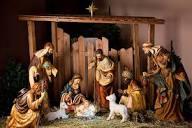
Today we light the white candle, which is the Christ candle, for it is Christmas day.
Each of the four evangelists has his own way of presenting the coming of the Messiah. We need to bear in mind that the gospels were written a few decades after the death of Jesus and so each account is looked at from a post-Resurrection perspective. Mark begins with Jesus’ baptism and does not even mention Joseph. John’s concentration is on the Word becoming flesh, the Word having existed from all eternity. Only Matthew and Luke have infancy stories; these are very brief and differ from one another. Their main purpose, however, is not to provide a biography but to proclaim Jesus as Lord and Saviour and to present in miniature the gospel story with the background of God’s plan of salvation, worked out through the Jewish people. There are echoes of Old Testament figures who can be paralleled with those in the narratives. The shepherds recall Jesus’ ancestor David, who cared for his father’s sheep; the Magi, Balaam and his vision of the star; and the Pharaoh who tried to destroy Moses is compared with Herod, who plotted to kill Jesus. Some people accept the Lord, some reject him. In his ministry he seeks out the poor and rejected.
In a recent television programme, the art critic, Waldemar Januszczak, showed how the Nativity story took on new dimensions with the paintings of the great masters. The ox and the ass appear, bringing to mind the words of Isaiah: “The ox knows its master, the ass its owner’s manger” (Is 1:3). The humble animals recognise what others do not. The Holy Family is pictured in a shed. Often they appear in the homeland of the artist and in contemporary dress. Symbols of the future of the child are depicted by Piero della Francesca in his version of the Nativity. The goldfinch has a head the colour of blood and the magpie on the roof is a symbol of death. Thus through history the short biblical stories have been elaborated on to provide colourful detail. This would be very much in harmony with the spirituality of St Ignatius, who invited people to imagine gospel scenes to enrich their prayer.